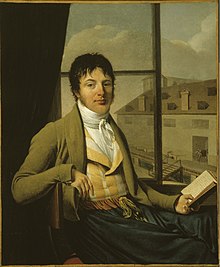
Back جان أنطوان شابتال Arabic جان انطوان شابتال ARZ Jean-Antoine Chaptal Catalan Jean-Antoine Chaptal Czech Jean-Antoine Chaptal German Jean-Antoine Chaptal Esperanto Jean-Antoine Chaptal Spanish Jean-Antoine Chaptal French Jean-Antoine Chaptal Croatian Jean-Antoine Chaptal Hungarian
Jean-Antoine Chaptal | |
|---|---|
 Portrait by Louis-André-Gabriel Bouchet (1801) | |
| Born | 5 June 1756[1] |
| Died | 29 July 1832 (aged 76)[1] |
| Resting place | Père Lachaise Cemetery |
| Nationality | French |
| Scientific career | |
| Fields | chemistry |
Jean-Antoine Chaptal, comte de Chanteloup (5 June 1756[1] – 29 July 1832[1]) was a French chemist, physician, agronomist, industrialist, statesman, educator and philanthropist. His multifaceted career unfolded during one of the most brilliant periods in French science. In chemistry it was the time of Antoine Lavoisier, Claude-Louis Berthollet, Louis Guyton de Morveau, Antoine-François Fourcroy and Joseph Gay-Lussac. Chaptal made his way into this elite company in Paris beginning in the 1780s, and established his credentials as a serious scientist most definitely with the publication of his first major scientific treatise, the Ėléments de chimie (3 vols, Montpellier, 1790). His treatise brought the term "nitrogen" into the revolutionary new chemical nomenclature developed by Lavoisier. By 1795, at the newly established École Polytechnique in Paris, Chaptal shared the teaching of courses in pure and applied chemistry with Claude-Louis Berthollet, the doyen of the science. In 1798, Chaptal was elected a member of the prestigious Chemistry Section of the Institut de France. He became president of the section in 1802 soon after Napoleon appointed him Minister of Interior (6 November 1800). Chaptal was a key figure in the early industrialization in France under Napoleon and during the Bourbon Restoration. He was a founder and first president in 1801 of the important Society for the Encouragement of National Industry and a key organizer of industrial expositions held in Paris in 1801 and subsequent years. He compiled a valuable study, De l'industrie française (1819), surveying the condition and needs of French industry in the early 1800s.
Chaptal was especially strong in applied science. Beginning in the early 1780s, he published a continuous stream of practical essays on such things as acids and salts, alum, sulfur, pottery and cheese making, sugar beets, fertilizers, bleaching, degreasing, painting and dyeing. As a chemicals industrialist, he was a major producer of hydrochloric, nitric and sulfuric acids, and was much sought after as a technical consultant for the manufacture of gunpowder. His reputation as a master of applied science, dedicated to using the discoveries of chemistry for the benefit of industry and agriculture, was furthered with the publication of his L'Art de faire, de gouverner et de perfectionner les vins (1801) and La Chimie appliquée aux arts (1806), works that drew on the theoretical chemistry of Lavoisier to revolutionize the art of wine-making in France. He promoted the procedure of adding sugar to increase the final alcohol content of wines is now called "chaptalization." In 1802, Chaptal purchased the Château de Chanteloup and its extensive grounds in Touraine, near Amboise. He raised merino sheep and experimented there in his later years on a model farm for the cultivation of sugar beets. He wrote his classic study of the application of scientific principles to the cultivation of land, the Chimie appliquée à l'agriculture (1823), and composed his important political memoir, Mes souvenirs sur Napoléon (1893). Napoleon named Chaptal Count of the Empire (1808) and Count of Chanteloup (1810). In 1819 he was named by Louis XVIII to the Restoration's Chamber of Peers.[2]
- ^ a b c d "Chaptal, cte de Chanteloup; Jean Antoine". Legion of Honour in Base Léonore (in French). Retrieved 2023-01-07.
- ^ See Jean Pigeire, La vie et l'oeuvre de Chaptal (1756–1832) (Paris, 1932); Maurice Crosland, The Society of Arcueil: A View of French Science at the Time of Napoleon (London, 1967); Maurice Crosland, "Jean Antoine Chaptal," in Complete Dictionary of Scientific Biography, vol 3 (2008); Jeff Horn & Margaret Jacob, "Jean-Antoine Chaptal and the Cultural Roots of French Industrialization," Technology and Culture,Vol 39, No.4 (1998); Jeff Horn, The Path Not Taken: French Industrialization in the Age of Revolution, 1750–1830 (2006); Harold T. Parker, "Jean-Antoine Chaptal," in Owen Connelly (ed), Historical Dictionary of Napoleonic France, 1799–1815 (1985); Pierre Flourens, "Éloge historique de Jean-Antoine Chaptal," Mémoires de l'Académie des Sciences, vol 15 (1838).